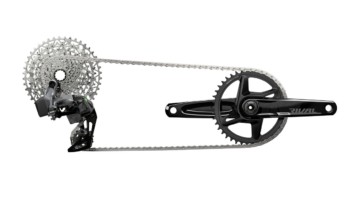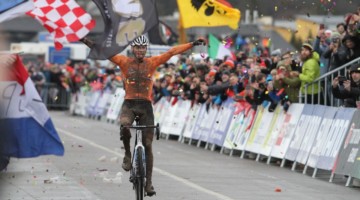Given cyclocross’s classification as a niche sport, books about ’cross are a rare commodity. Fortunately for cyclocross fans, “Rainbows in the Mud” by British writer Paul Maunder adds a title to the canon of ’cross books that includes Simon Burney’s cyclocross bible, Bill Schieken’s “Skills, Drills and Bellyaches,” Molly Hurford’s “Mud, Snow and Cyclocross” and Geoff Proctor’s “Behind the Stare.”
In “Rainbows in the Mud” Maunder applies his experience as a journalist for Peloton and other publications to tell the story of the sport of cyclocross via the arc of the 2015/16 season. Katie Compton and Gage Hecht are the two primary characters in the story—and countless other familiar faces make cameo appearances—but the lead role in “Rainbows in the Mud” is played by the sport of cyclocross. Belgium, the legendary courses, the races, the friets, the racers; it is the sum total of all these parts of cyclocross that Maunder deftly wraps together into a compelling story.
“Rainbows in the Mud“ takes on the daunting task of telling the story of a sport and scores a podium finish for the effort. One of the challenges of books such as this is providing content that appeals to readers from the different realms of ’crossdom. New readers are likely to find the descriptions of the history and culture of the sport interesting and perhaps an invitation to wake up at 6 a.m. to catch the Superprestige races this season, and old hands should still welcome the inside look at the European scene that is difficult to obtain from grainy feeds bootlegged over the internet.
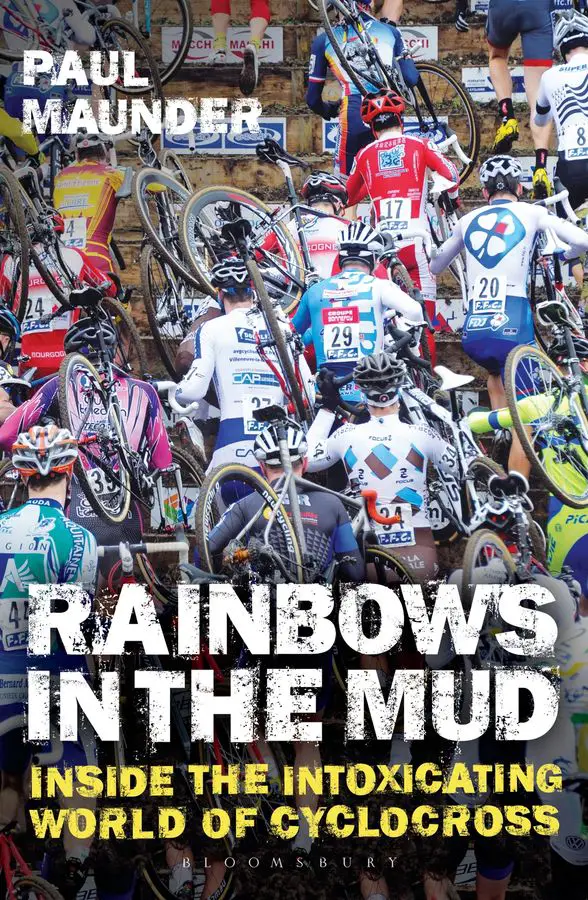
Rainbows in the Mud is the new book about the 2015/16 cyclocross season from Paul Maunder. photo: courtesy
A Labor of Re-Discovery for Paul Maunder
One aspect of cycling journalism that seems to set it apart from other sports is many cycling writers are racers themselves. On the surface, this creates an interesting dynamic where cycling writers bring a certain level of practical knowledge to their coverage. Your average cycling writer can race the course at Jingle Cross or attempt to summit Mont Ventoux, albeit much slower than the pros, and thus bring some real-world knowledge to their coverage. Contrast this with say, an NBA writer knowing what it’s like to try to score on LeBron James or an NFL writer battling in the trenches. On a deeper level, the participatory nature of cycling means most of us in the cycling media have an underlying passion for the sport that drives us and colors our writing about it in a way that may not occur in other sports.
Paul Maunder shares a story of love the cyclocross that is probably familiar to a lot of adults who ride bikes. Maunder begins the book by recounting his first cyclocross race in an Oxford field at age 11 and how he fell in love with the sport after riding around in a pair of hockey boots provided by his father. He also describes the excitement of learning that Briton Stuart Marshall won the Junior World Championships in 1986 and how he knew that Roger Hammond, who won Junior Worlds in 1992, would grow up to be something special after getting beat by him as a young boy.
Like many young men and women who participate in cycling as a Junior, Maunder fell away from the sport as he got older, only to find his way back as an adult. This story is not uncommon among adults who race bikes, and hopefully they are able to tap into that youthful joy when they re-discover cycling later on. Although Maunder admits he will likely never line up for a race such as the famed Three Peaks Cyclocross race himself, there is a certain sense of that youthful love for the sport that Maunder brings to the prose of “Rainbows in the Mud.”
A Journey from August to January in “Rainbows in the Mud”
In the Introduction of “Rainbows in the Mud,” Paul Maunder describes his goal for the book, “It is tempting then for a writer to attempt a full history of the sport—an encyclocrosspedia, so to speak. I have resisted this temptation, principally because such a book would have bored me rigid. Given the choice, I prefer insight over information.”
The backdrop for “Rainbows in the Mud” is the 2015/16 cyclocross season. The story starts in late July/early August at one of the many road races European riders use as training for cyclocross season and extends all the way through to the World Championships in January. The two main recurring characters are Katie Compton and Gage Hecht, and a long list of familiar names pop up throughout the narrative.
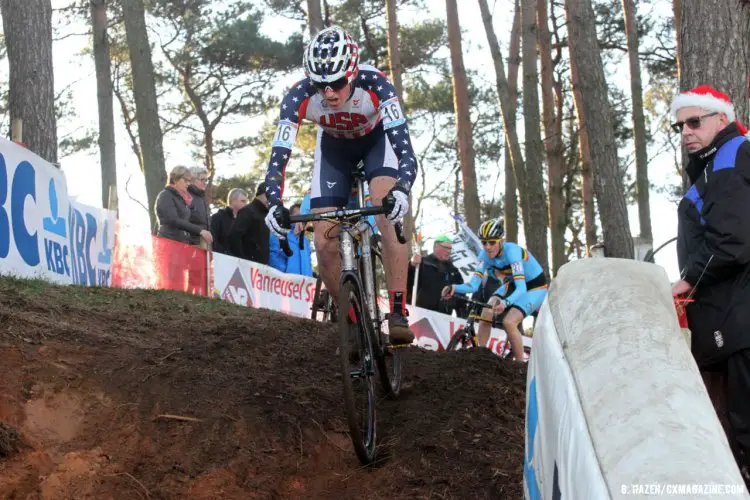
Gage Hecht, seen here at Zolder in 2015, is one of the recurring characters in Rainbows in the Mud. 2015 World Cup Zolder. © Bart Hazen
In some cases, producing quality non-fiction is about being in the right place at the right time. Compton’s inclusion in “Rainbows in the Mud” is compelling because 2015 was the year she started to address her long-term health issues, and after missing much of her training during the summer of 2015, she faced a tough road back to the top of the sport. As the season moves from CrossVegas to Koksijde and into the depths of the Belgian winter, the reader is able to follow Compton’s journey back to health while dealing with the ups and downs in her trademark no-nonsense fashion.
Despite being from Britain, Maunder spends a fair amount of time on U.S. cyclocross and the challenges its riders face when heading over to Europe to compete. Hecht is an interesting character because his story highlights the challenges and stresses U.S. Junior riders face even while putting up very impressive results. One great moment in the book occurs when Maunder catches Hecht getting ready for U.S. Nationals in Asheville and contrasts his relaxed demeanor on home soil with the intense persona he saw from Hecht in Europe. Maunder’s inclusion of Hecht in the story provides interesting insight into the Euro Cross Camp program and the pressure young U.S. men and women face when heading over to Europe knowing the trip may be their one chance to excel on the world’s biggest cyclocross stage.
Friets, Mayonnaise and Parking Spots
The main character in “Rainbows in the Mud” is the sport of cyclocross, specifically cyclocross in Belgium. Belgium, and particularly Flanders, is the cultural heart of the sport, but it is also an insular province that has shown little interest in expanding the sport outside its borders. Belgium is at an interesting point in its cyclocross arc, with the nation experiencing a two-decade run of growth fueled by expanded television broadcasts and the popularity of Sven Nys. If there is a fundamental conflict in “Rainbows in the Mud,” it is the tension between the growing internationalization of the sport and Flanders’ primacy in the post-Sven world.
Maunder’s writing in “Rainbows in the Mud” shines the brightest when he is describing his experiences of attending cyclocross races in Europe. The list of events he attended is impressive: Koksijde, Koppenberg, Druivencross, Namur and Worlds at Zolder. He brings the events to life with an effective balance of history, atmosphere and racing that provides a window into the events many of us only experience on our computer screens with varying levels of clarity. He also brings races from the U.S. and Britain into the narrative to highlight the expansion of the sport into the English-speaking world.
Maunder’s depiction of the atmosphere of European cyclocross begins with, of course, friets. In fact, along with Compton and Hecht, the other regular throughout the book is friets and the array of sauces available for fans to choose from—Maunder’s advice is to go for the mayonnaise every time, in case the reader is wondering. Other interesting/amusing tidbits he highlights are the pecking order of parking lot assignments and an entertaining afternoon with the Kevin Pauwels Fan Club. And since the book takes place during the year of the Zolder Worlds, there is the story of Femke Van den Driessche and a sly reference to her “motoring” up the Koppenberg hill.
One unique skill Maunder brings to the book is his ability to express the importance of place in the sport of cyclocross. Physical features play an important role in how cyclocross courses are laid out and riders are constantly forced to think about how corners and features are changing throughout the race. Riders are willing to travel long distances to races whose physical features create a challenging and memorable race experience and complain about the “grass crits” that seemingly lack any terrain of notes.
In “Rainbows in the Mud,” Maunder initiates his discussion of place when he visits Yorkshire in England for the annual Three Peaks Cyclocross race. The Three Peaks Race is a unique cyclocross race that is 38 miles long, of which four is unrideable on a good day. Over half the race is off-road, thus fulfilling the translation of veldrijden, the Dutch word for cyclocross: field-driving. Maunder continues to highlight the role the landscape plays in defining many races on the European circuit: the Koppenberg hill, the sand dunes of Koksijde, the Citadel of Namur. Cyclocross and place are intertwined for these races and Maunder does a fine job capturing the inseparable relationship between the two.
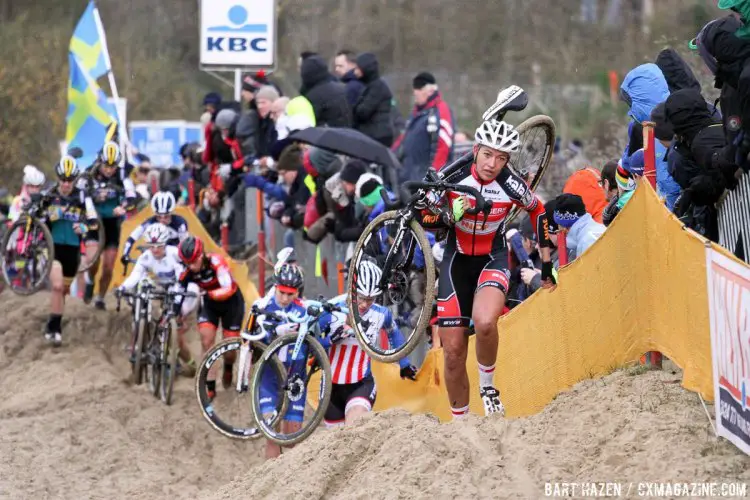
Physical features like the dunes of Koksijde are one of the stars of Rainbows in the Mud. 2015 Koksijde World Cup Women. © B. Hazen / Cyclocross Magazine
When the Cowbells Fade and the Book is Written
“Rainbows in the Mud” really starts to hit its stride in the second half of the book when Hecht and Compton play a more prominent role in the story. Using characters to tell a bigger story is an effective approach for a book like this, so one way it could have been improved is to add a character or two to help lock in the reader’s interest early on. The 2015/16 season was Sven Nys’ retirement year and the contrast between the departure of Nys and the rise of Wout van Aert would have made for a fascinating story. The story of Evie Richards and her magical run to the U23 World Championship or the emergence of Tom Pidcock, Dan Tulett and Ben Turner as British stars (but may have happened too late in the writing process) would also have been fitting themes for the British author.
The review copy of “Rainbows in the Mud” provided to Cyclocross Magazine did not have any photographs or illustrations included. Given the sport’s unique aspects and the focus on the places of cyclocross, including photographs would have enhanced Maunder’s descriptive ability. Dedicated ’cross fans may know what it looks like to slog through the mud on foot or descend the sand dunes at Koksijde, but readers who have less experience with cyclocross may have difficulty painting that mental picture.
Having said that, overall “Rainbows in the Mud” is successful in telling the story of cyclocross through the characters, places and races of the 2015/16 season. Paul Maunder’s journalistic eye and skill with the written word helps bring the mud of Belgium alive and it is a fair bet many readers will be left hoping he chooses to write another book or three about the sport of cyclocross.
“Rainbows in the Mud” is currently available in Britain and will be available in the U.S. on September 5. The book is available at Amazon and select retailers.
[amazon_link asins=’1472925955′ template=’ProductAd’ store=’cyclocross0d-20′ marketplace=’US’ link_id=’059cf836-da63-11e7-b161-f962e718622e’]
Note: CXM is never paid to review a product but earns a small commission on book sales through purchases made via the above Amazon links.























